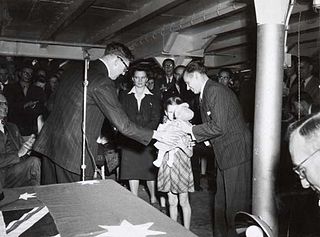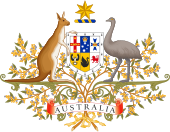
The White Australia policy is a term encapsulating a set of historical policies that aimed to forbid people of non-European ethnic origin, especially Asians and Pacific Islanders, from immigrating to Australia, starting in 1901. Governments progressively dismantled such policies between 1949 and 1973.

Arthur Augustus Calwell was an Australian politician who served as the leader of the Labor Party from 1960 to 1967. He led the party to three federal elections.

The term "British subject" has several different meanings depending on the time period. Before 1949, it referred to almost all subjects of the British Empire. Between 1949 and 1983, the term was synonymous with Commonwealth citizen. Currently, it refers to people possessing a class of British nationality largely granted under limited circumstances to those connected with Ireland or British India born before 1949. Individuals with this nationality are British nationals and Commonwealth citizens, but not British citizens.

Canadian nationality law details the conditions in which a person is a national of Canada. With few exceptions, almost all individuals born in the country are automatically citizens at birth. Foreign nationals may naturalize after living in Canada for at least three years while holding permanent residence and showing proficiency in the English or French language. As Commonwealth citizens, Canadian citizens have favoured status when residing in the United Kingdom; those living in the U.K. are eligible to vote and serve in public office or non-reserved government positions.
Since 1945, immigration to the United Kingdom, controlled by British immigration law and to an extent by British nationality law, has been significant, in particular from the Republic of Ireland and from the former British Empire, especially India, Bangladesh, Pakistan, the Caribbean, South Africa, Nigeria, Ghana, Kenya, and Hong Kong. Since the accession of the UK to the European Communities in the 1970s and the creation of the EU in the early 1990s, immigrants relocated from member states of the European Union, exercising one of the European Union's Four Freedoms. In 2021, since Brexit came into effect, previous EU citizenship's right to newly move to and reside in the UK on a permanent basis does not apply anymore. A smaller number have come as asylum seekers seeking protection as refugees under the United Nations 1951 Refugee Convention.

The Common Travel Area is an open borders area comprising the United Kingdom, Ireland, Isle of Man, and the Channel Islands. The British Overseas Territories are not included. Based on agreements that are not legally binding, the internal borders of the CTA are subject to minimal controls and can normally be traversed by British and Irish citizens with minimal identity documents. The maintenance of the CTA involves co-operation on immigration matters between the British and Irish authorities.
In law, an alien is any person who is not a citizen or a national of a specific country, although definitions and terminology differ to some degree depending upon the continent or region. More generally, however, the term "alien" is perceived as synonymous with foreign national.

The Immigration Restriction Act 1901 (Cth) was an Act of the Parliament of Australia which limited immigration to Australia and formed the basis of the White Australia policy which sought to exclude all non-Europeans from Australia. The law granted immigration officers a wide degree of discretion to prevent individuals from entering Australia. The Act prohibited various classes of people from immigrating and provided for illegal immigrants to be deported.

Australian nationality law details the conditions by which a person is a national of Australia. The primary law governing nationality regulations is the Australian Citizenship Act 2007, which came into force on 1 July 2007 and is applicable in all states and territories of Australia.

Canadian immigration and refugee law concerns the area of law related to the admission of foreign nationals into Canada, their rights and responsibilities once admitted, and the conditions of their removal. The primary law on these matters is in the Immigration and Refugee Protection Act, whose goals include economic growth, family reunification, and compliance with humanitarian treaties.

Al-Kateb v Godwin, was a decision of the High Court of Australia, which ruled on 6 August 2004 that the indefinite detention of a stateless person was lawful. The case concerned Ahmed Al-Kateb, a Palestinian man born in Kuwait, who moved to Australia in 2000 and applied for a temporary protection visa. The Commonwealth Minister for Immigration's decision to refuse the application was upheld by the Refugee Review Tribunal and the Federal Court. In 2002, Al-Kateb declared that he wished to return to Kuwait or Gaza. However, since no country would accept Al-Kateb, he was declared stateless and detained under the policy of mandatory detention.

Post-war immigration to Australia deals with migration to Australia in the decades immediately following World War II, and in particular refers to the predominantly European wave of immigration which occurred between 1945 and the end of the White Australia policy in 1973. In the immediate aftermath of World War II, Ben Chifley, Prime Minister of Australia (1945–1949), established the federal Department of Immigration to administer a large-scale immigration program. Chifley commissioned a report on the subject which found that Australia was in urgent need of a larger population for the purposes of defence and development and it recommended a 1% annual increase in population through increased immigration.

After Adolf Hitler came into power in 1933 and enacted policies that would culminate in the Holocaust, Jews began to escape German-occupied Europe and the United Kingdom was one of the destinations. Some came on transit visas, which meant that they stayed in Britain temporarily, while waiting to be accepted by another country. Others entered the country by having obtained employment or a guarantor, or via Kindertransport. There were about 70,000 Jewish refugees who were accepted into Britain by the start of World War II on 1 September 1939, and an additional 10,000 people who made it to Britain during the war.
The Australian government has a policy and practice of detaining in immigration detention facilities non-citizens not holding a valid visa, suspected of visa violations, illegal entry or unauthorised arrival, and those subject to deportation and removal in immigration detention until a decision is made by the immigration authorities to grant a visa and release them into the community, or to repatriate them to their country of origin/passport. Persons in immigration detention may at any time opt to voluntarily leave Australia for their country of origin, or they may be deported or given a bridging or temporary visa.
Asylum in Australia has been granted to many refugees since 1945, when half a million Europeans displaced by World War II were given asylum. Since then, there have been periodic waves of asylum seekers from South East Asia and the Middle East, with government policy and public opinion changing over the years.

The Migration Act 1958(Cth) is an Act of the Parliament of Australia that governs immigration to Australia. It set up Australia’s universal visa system (or entry permits). Its long title is "An Act relating to the entry into, and presence in, Australia of aliens, and the departure or deportation from Australia of aliens and certain other persons."

The War-time Refugees Removal Act 1949 was a piece of Australian legislation that formed part of the White Australia policy. It was introduced by the Chifley Government in July 1949, in order to give the federal government the explicit authority to deport non-white foreigners who had arrived in Australia during World War II.

Lorenzo Abrogar Gamboa was a Filipino-American man who was excluded from Australia under the White Australia policy, despite having an Australian wife and children. His treatment sparked an international incident with the Philippines.

O'Keefe v Calwell is a High Court of Australia case.

Asian Australian history is the history of Asian ethnic and racial groups in Australia who trace their ancestry to Asia. The term Asian Australian, was first used in the 1950s by European Australians who wanted to strengthen diplomatic and trade ties with Asia for the benefit of the Australian community. The term was not originally used to describe or recognise the experiences of people of Asian descent living in Australia. It was only in the late 1980s and 1990s that the term "Asian Australian" was adopted and used by Asian Australians themselves to discuss issues related to racial vilification and discrimination. Today, the term "Asian Australian" is widely accepted and used to refer to people of Asian descent who are citizens or residents of Australia, though its usage and meaning may vary within the Asian Australian community.










